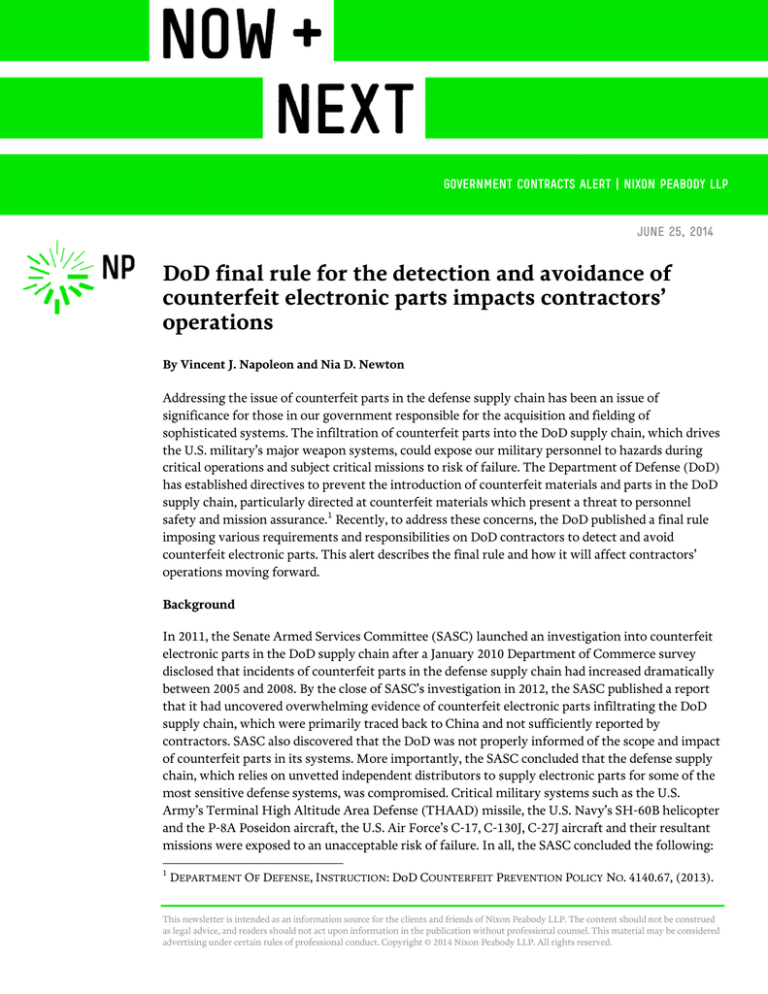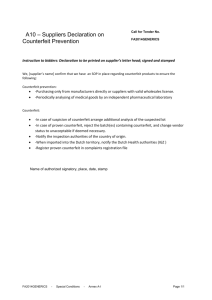
Government contracts alert | Nixon Peabody LLP
June 25, 2014
DoD final rule for the detection and avoidance of
counterfeit electronic parts impacts contractors’
operations
By Vincent J. Napoleon and Nia D. Newton
Addressing the issue of counterfeit parts in the defense supply chain has been an issue of
significance for those in our government responsible for the acquisition and fielding of
sophisticated systems. The infiltration of counterfeit parts into the DoD supply chain, which drives
the U.S. military’s major weapon systems, could expose our military personnel to hazards during
critical operations and subject critical missions to risk of failure. The Department of Defense (DoD)
has established directives to prevent the introduction of counterfeit materials and parts in the DoD
supply chain, particularly directed at counterfeit materials which present a threat to personnel
safety and mission assurance.1 Recently, to address these concerns, the DoD published a final rule
imposing various requirements and responsibilities on DoD contractors to detect and avoid
counterfeit electronic parts. This alert describes the final rule and how it will affect contractors’
operations moving forward.
Background
In 2011, the Senate Armed Services Committee (SASC) launched an investigation into counterfeit
electronic parts in the DoD supply chain after a January 2010 Department of Commerce survey
disclosed that incidents of counterfeit parts in the defense supply chain had increased dramatically
between 2005 and 2008. By the close of SASC’s investigation in 2012, the SASC published a report
that it had uncovered overwhelming evidence of counterfeit electronic parts infiltrating the DoD
supply chain, which were primarily traced back to China and not sufficiently reported by
contractors. SASC also discovered that the DoD was not properly informed of the scope and impact
of counterfeit parts in its systems. More importantly, the SASC concluded that the defense supply
chain, which relies on unvetted independent distributors to supply electronic parts for some of the
most sensitive defense systems, was compromised. Critical military systems such as the U.S.
Army’s Terminal High Altitude Area Defense (THAAD) missile, the U.S. Navy’s SH-60B helicopter
and the P-8A Poseidon aircraft, the U.S. Air Force’s C-17, C-130J, C-27J aircraft and their resultant
missions were exposed to an unacceptable risk of failure. In all, the SASC concluded the following:
1
DEPARTMENT OF DEFENSE, INSTRUCTION: DoD COUNTERFEIT PREVENTION POLICY NO. 4140.67, (2013).
This newsletter is intended as an information source for the clients and friends of Nixon Peabody LLP. The content should not be construed
as legal advice, and readers should not act upon information in the publication without professional counsel. This material may be considered
advertising under certain rules of professional conduct. Copyright © 2014 Nixon Peabody LLP. All rights reserved.
China is the dominant source for counterfeit electronic parts that are infiltrating the
defense supply chain.
The Chinese Government has failed to take steps to stop counterfeiting operations that are
carried out openly in that country.
The DoD lacks knowledge of the scope and impact of counterfeit parts on critical defense
systems.
The use of counterfeit electronic parts in defense systems can compromise performance
and reliability, risk national security and endanger the safety of military personnel.
Permitting contractors to recover costs incurred as a result of their own failure to detect
counterfeit electronic parts does not encourage the adoption of aggressive counterfeit
avoidance and detection programs.
The defense industry’s reliance on unvetted independent distributors to supply electronic
parts for critical military applications results in unacceptable risks to national security and
the safety of U.S. military personnel.
Weaknesses in the testing regime for electronic parts create vulnerabilities that are
exploited by counterfeiters.
The defense industry routinely failed to report cases of suspect counterfeit parts, putting
the integrity of the defense supply chain at risk.
As a result of the 2012 SASC report, the DoD released a proposed rule in May 2013 that would
implement Section 818 of the 2012 National Defense Authorization Act (NDAA) and Section 833
of the 2013 NDAA (“Proposed Rule”). The Proposed Rule would modify the Defense Federal
Acquisition Regulation Supplement (DFARS) by requiring DoD contractors to detect and avoid
counterfeit electronic parts. More specifically, the §818 proposal would require the Secretary of
Defense to assess the DoD’s acquisition policies and systems for the detection and avoidance of
counterfeit electronic parts. Section 833 would impose counterfeit prevention obligations on
defense contractors who were subject to Cost Accounting Standards (CAS) and that supplied
electronic parts or products that include electronic parts under CAS-covered contracts. Those
contractors would be responsible for avoiding and detecting the use or inclusion of counterfeit
electronic parts or suspect-counterfeit electronic parts by developing counterfeit electronic part
avoidance and detection systems that would implement policies and procedures. The policies and
procedures address:
1) Training of personnel;
2) Inspection and testing of electronic parts, including criteria for acceptance and
rejection;
3) Processes to abolish counterfeit parts proliferation;
4) Mechanisms to enable traceability of parts to suppliers;
5) Use and qualification of trusted suppliers;
6) Reporting and quarantining of counterfeit electronics parts and suspect-counterfeit
electronic parts;
7) Methodologies to identify suspect-counterfeit parts;
8) Design, operation and maintenance of systems to detect and avoid counterfeit
electronic parts and suspect-counterfeit parts; and
9) Flow down of counterfeit avoidance and detection requirements to subcontractors.
On May 16, 2014, the DoD issued its final rule on how contractors should address and treat the
issue of counterfeit electronic parts in their supply chain when responding to government
requirements (“Final Rule”). The DoD’s Final Rule significantly changes contractor responsibilities
to detect and avoid the use or inclusion of counterfeit or suspect-counterfeit electronic parts, the
use of trusted suppliers and contractors’ reporting requirements of counterfeit and suspectcounterfeit electronic parts. Among the Final Rule changes is the imposition of a new DFARS
clause 252.246-7007 (titled Contractor Counterfeit Electronic Part Detection and Avoidance System
(May 2014)) that establishes actions contractors must take to develop and maintain an acceptable
counterfeit part detection and avoidance system when contractors supply electronic parts or
assemblies containing electronic parts to the government.
DFARS 252.246-7007
DFARS 252.246-7007 limits its coverage to those contractors subject to Cost Accounting Standards
(CAS) as outlined in 41 U.S.C. §1501 et seq. However, DFARS acknowledges that all levels of the
supply chain have the potential to introduce counterfeit or suspect-counterfeit electronic items
into the end items contracted for under a CAS-covered prime contract. Ultimately, responsibility
for preventing introduction of counterfeit parts “flows down” to all subcontractors and suppliers of
CAS-covered prime contractors regardless of the coverage or size of the subcontractors or suppliers.
Counterfeit electronic part detection and avoidance system criteria
Under the Final Rule, the DoD renders contractors responsible for establishing and maintaining an
acceptable counterfeit electronic part detection and avoidance system, which must include riskbased policies and procedures that address, at a minimum, twelve enumerated areas. In addition to
the nine policy and procedure areas outlined in the Proposed Rule, the Final Rule outlines three
additional policies and procedures that should be established and implemented and would result in
an adequate counterfeit electronic part avoidance and detection system. These policies and
procedures include establishing and implementing the following: 1) a process for keeping
continually informed of current counterfeiting information and trends; 2) a process for screening
Government-Industry Data Exchange Program (GIDEP) reports and other credible sources of
counterfeiting information; and 3) a process for controlling obsolete electronic parts.
Notwithstanding these additional requirements, the DoD does not endorse specific mechanisms or
technologies to satisfy the twelve requirements. Failure to maintain an acceptable counterfeit
electronic part avoidance and detection system could result in the contracting officer’s disapproval
of the contractor’s purchasing system and could cause a withholding of payments to the contractor.
Cost allowability
The Final Rule shifts the risk and cost of counterfeit parts to contractors. The rule establishes that
costs of rework or corrective action when counterfeit parts were improperly introduced into the
DoD supply chain are unallowable. However, the DoD’s proposal did provide specific exceptions
that would enable costs to be reimbursed when a contractor 1) had a DoD-reviewed and approved
operational system to detect and avoid counterfeit parts, 2) the counterfeit or suspect-counterfeit
electronic parts were provided as government-furnished property and 3) the contractor provided
notice to the government within 60 days of becoming aware of a counterfeit or suspect counterfeit
electronic part. Some government contracting practitioners agree that while most contractors may
be able to meet these requirements, subcontractors and suppliers which do not operate on a cost
reimbursement basis with the government are unlikely to have their costs allowed. In the case of
contractors performing pursuant to cost reimbursement contracts, reimbursement of costs will be
based on the FAR principles of cost allowability.
Definitional concerns
The Final Rule is limited to electronic parts and specifically covers counterfeit electronic parts,2
suspect counterfeit electronic parts,3 and obsolete electronic parts.4 While there are no apparent
and significant differences between the definition of these terms in the Proposed Rule and the Final
Rule, there is concern among some commenters to the Proposed Rule regarding the “credible
evidence” standard used in the definition of suspect counterfeit electronic parts and the lack of
guidance given in the definition of obsolete electronic parts. Some commenters to the Proposed
Rule argue that the “credible evidence” standard (equivalency of a reasonableness standard) is
overbroad and the absence of a designated procedure for determining whether a part is suspect
counterfeit makes contractors and suppliers more vulnerable to unintentionally violating the
DFARS mandatory disclosure rules. The DoD’s response to these concerns recognizes that it is not
practical or cost-effective to test every case of a suspected counterfeit, but that the phrase “credible
evidence” along with examples strengthens a fact-based approach.
Commenters to the Proposed Rule also express concern that the definition of obsolete parts does
not address known risks and challenges of the DoD’s continued use of obsolete and out-ofproduction parts, the vulnerabilities created by the continued demand for such parts, and the
increasing constraint on DoD’s ability to support and find ways to eliminate continued dependence
2
A counterfeit electronic part is defined as “unlawful or unauthorized reproduction, substitution, or
alteration that has been knowingly mismarked, misidentified, or otherwise misrepresented to be an
authentic, unmodified electronic part from the original manufacture, or a source with the express
written authority of the original manufacturer, or a source with the express written authority of the
original manufacturer. Unlawful or unauthorized substitution is described to include used electronic
parts represented as new, or the false identification of grade, serial number, lot number, date code, or
performance characteristics.”
3
A suspect counterfeit part is defined as “an electronic part for which credible evidence (including, but
not limited to, visual inspection or testing) provides reasonable doubt that the electronic part is
authentic.”
4
An obsolete electronic part is defined as “an electronic part that is no longer in production by the
original manufacturer or an aftermarket manufacture that has been provided express written
authorization from the current design activity or original manufacturer.”
on these parts. Commenters note that electronic parts have life cycles far shorter than the defense
and aerospace products using them, so guidance from the DoD on what processes to use to mitigate
risks inherent with obsolete parts is essential for contractor compliance. Obsolescence control is a
fundamental aspect of counterfeit prevention and should be addressed by the contractor in its
counterfeit detection and avoidance system.
Looking ahead
To ensure that counterfeit materials do not present a threat to U.S. personnel and mission
assurance, the DoD’s Final Rule obligates all contractors providing electronic parts to the
government to take proactive steps to identify and prevent counterfeit components from entering
the DoD supply chain. This means that contractors are absorbing a greater burden in protecting
and insulating the DoD supply chain from the risk of compromise. As a result of this burden,
contractors will incur far greater costs for ensuring that their counterfeit detection and avoidance
systems are appropriate and capable of minimizing the risk of exposure inherent in a compromised
supply chain system. Increased liability also means that contractors will now be responsible for
keeping subcontractors and suppliers accountable for the electronic parts that subcontractors and
suppliers introduce to the market. This will likely force some contractors to expand the scope of
their internal audit and compliance teams to review and audit the counterfeit detection and
avoidance systems, which will inevitably raise contractors’ costs.
One of the more challenging areas for contractors going forward is their response to the Final
Rule’s reference to obsolete parts that are no longer being produced and not easily traceable to the
original manufacturer. Certainly, some contractors may be left with only two options as they
attempt to address this issue—contractors may either engage in the costly option of stocking up on
parts while they are being made by original manufacturers or be forced to ensure that obsolete
parts being purchased are from trusted suppliers. No matter the decisions, if contractors have to
implement systems that account for obsolete parts compliance, the overall price of contractors’
contracts with the government will likely increase.
The DoD claims that new requirements should not affect small business contractors; however, it is
conceivable that higher costs, risks and liabilities could be detrimental to a smaller firm that does
not have the money to establish new systems or hire new people. Because suppliers and
subcontractors do not operate on a cost reimbursement basis with the government, they may also
increase their prices to include such costs. As a result, prime contractors can anticipate paying more
for the contracts with their subcontractors or suppliers.
For more information on the content of this alert, please contact your Nixon Peabody attorney or:
— Vincent J. Napoleon at vnapoleon@nixonpeabody.com or 202-585-8379




